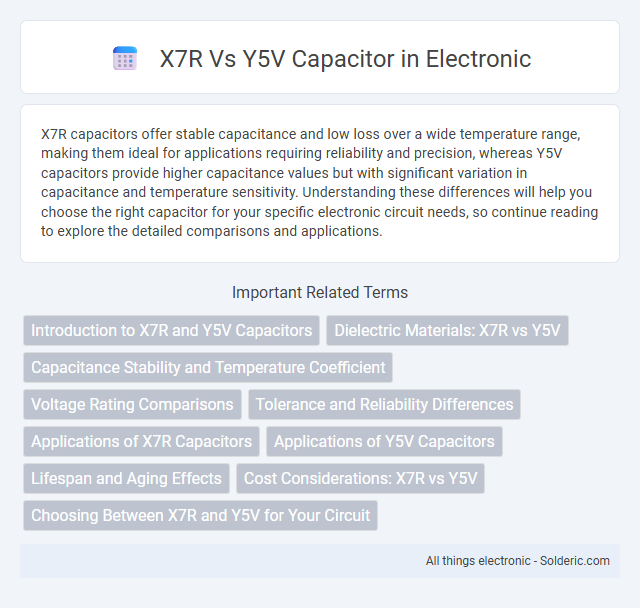X7R capacitors offer stable capacitance and low loss over a wide temperature range, making them ideal for applications requiring reliability and precision, whereas Y5V capacitors provide higher capacitance values but with significant variation in capacitance and temperature sensitivity. Understanding these differences will help you choose the right capacitor for your specific electronic circuit needs, so continue reading to explore the detailed comparisons and applications.
Comparison Table
| Feature | X7R Capacitor | Y5V Capacitor |
|---|---|---|
| Temperature Range | -55degC to +125degC | -30degC to +85degC |
| Capacitance Stability | +-15% over temperature | +22% / -82% over temperature |
| Dielectric Material | Barium Titanate (Class II) | Barium Titanate (Class II) |
| Application | General purpose, stable filtering | High capacitance in small size, less stability |
| Voltage Rating | Up to 50V commonly | Up to 50V commonly |
| Capacitance Range | 1pF to 10uF | 1nF to 10uF |
| Cost | Moderate | Lower cost |
| Usage | Reliable for timing and filtering | Used where high capacitance is critical and tolerance is relaxed |
Introduction to X7R and Y5V Capacitors
X7R and Y5V capacitors are types of ceramic capacitors classified under the EIA temperature characteristics code, designed for different temperature stability and capacitance tolerance. X7R capacitors offer a temperature range of -55degC to +125degC with capacitance variation within +-15%, making them suitable for general-purpose applications requiring moderate stability. Y5V capacitors operate within -30degC to +85degC with a wide capacitance tolerance of +22% to -82%, providing high capacitance density but lower temperature and voltage stability compared to X7R.
Dielectric Materials: X7R vs Y5V
X7R capacitors utilize a stable ceramic dielectric material designed to maintain capacitance within +-15% over a temperature range of -55degC to 125degC, making them suitable for general-purpose applications requiring moderate stability. Y5V capacitors employ a high-permittivity ceramic dielectric that offers a wider capacitance range but suffers from significant capacitance variability, with tolerance spanning +22% to -82% and a temperature range of -30degC to 85degC. The dielectric composition in X7R ensures improved temperature stability and reliability compared to the more temperature-sensitive Y5V type, which is often chosen for cost-sensitive, less critical applications.
Capacitance Stability and Temperature Coefficient
X7R capacitors offer better capacitance stability with a temperature coefficient of +-15% over a wide temperature range (-55degC to +125degC), making them suitable for applications requiring moderate precision. Y5V capacitors exhibit a much larger capacitance variation, with a temperature coefficient ranging from +22% to -82% between -30degC and +85degC, leading to less predictable performance. Understanding these differences helps you select the right capacitor for temperature-sensitive electronic circuits.
Voltage Rating Comparisons
X7R capacitors have a stable voltage rating typically ranging from 6.3V to 100V, offering consistent performance under varying voltage stresses. Y5V capacitors, however, generally feature lower voltage ratings between 10V and 50V and exhibit significant capacitance variation with voltage changes. When selecting capacitors for your circuit, X7R provides better voltage stability and reliability compared to Y5V under typical operating conditions.
Tolerance and Reliability Differences
X7R capacitors offer tighter tolerance ranges, typically +-15%, ensuring more consistent performance in precision applications compared to Y5V capacitors, which have wider tolerances around +80%/-20%. Reliability of X7R capacitors is higher due to their stable temperature coefficients and better voltage stability, while Y5V types tend to exhibit significant capacitance variations with temperature and applied voltage. Choosing X7R capacitors is preferred for circuits demanding stable capacitance and long-term reliability under varied environmental conditions.
Applications of X7R Capacitors
X7R capacitors are widely used in applications requiring stable capacitance over a broad temperature range of -55degC to 125degC, such as in power supply filtering and decoupling circuits. Their moderate dielectric constant and voltage stability make them suitable for general-purpose applications in consumer electronics, automotive systems, and industrial equipment. These capacitors effectively manage noise suppression and transient voltage absorption, ensuring reliable performance in demanding environments.
Applications of Y5V Capacitors
Y5V capacitors are commonly used in applications requiring high capacitance in a compact size, such as decoupling and filtering in consumer electronics, power supplies, and telecommunications equipment. Their high dielectric constant allows for a larger capacitance value per volume, although they exhibit high temperature and voltage dependence, making them less suitable for precision circuits. Your choice of Y5V capacitors should consider their lower stability and higher variance compared to X7R types, especially in temperature-sensitive environments.
Lifespan and Aging Effects
X7R capacitors provide a longer lifespan and more stable performance over time compared to Y5V capacitors, which experience significant capacitance loss and degradation due to aging effects. The X7R dielectric material maintains capacitance within +-15% over a wide temperature range, making it ideal for applications requiring durability and reliability. Your choice between the two should consider the impact of aging on capacitance stability and overall longevity of the component in your circuit design.
Cost Considerations: X7R vs Y5V
X7R capacitors generally cost more than Y5V due to their superior temperature stability and reliability across a wider temperature range (-55degC to 125degC for X7R versus -30degC to 85degC for Y5V). Y5V capacitors are less expensive but exhibit significant capacitance variation and reduced lifespan under thermal stress, making them suitable for cost-sensitive applications where precision is not critical. Choose X7R if your project demands consistent performance despite a higher upfront cost, while Y5V suits budget-conscious designs with less stringent stability requirements.
Choosing Between X7R and Y5V for Your Circuit
Choosing between X7R and Y5V capacitors depends on the required temperature stability and capacitance tolerance for your circuit. X7R capacitors offer a temperature range of -55degC to 125degC with +-15% capacitance variation, making them suitable for applications needing moderate stability. Y5V capacitors provide a wider tolerance of +22%/-82% and operate from -30degC to 85degC, fitting scenarios where high capacitance density is needed but precision is less critical.
X7R vs Y5V capacitor Infographic

 solderic.com
solderic.com